Let's Go !
Suitengu-Mae - Tsukuda-jima - Toyomi Pier
Todays course started off from a hotem at Suitengu Mae, which is not too far from Tokyo Station. Suitenguu Mae is a convinient location to stay as it is close to central Tokyo, and TCAT(Tokyo City Air Terminal) close by.
Leaving Suitenguu Mae, ride on Shin Ohashi Dori towards Tsukiji, heading for our initial destination of Tsukishma. Along the way, make a brief stop at the Wall Street of Tokyo, Kabuto-Cho. Take a look at the Tokyo Stock Exchange, and the security firms around the district.
[MAPID 1 :Tokyo Stock Exchange]
Tokyo Stock Exchange, Inc.
Founding : April 1, 1949
Capital : 11.5 Billion yen
Issued Shares : 2,300,000 shares In the 1870's, a securities system was introduced in Japan and public bond negotiation began. The "Tokyo Stock Exchange Co., Ltd." was established on May 15, 1878; and trading began on June 1st. After WW-II, the Securities and Exchange Law was enacted in March of 1947, and entirely revised in April of 1948. On April 1, 1949, three stock exchanges were established in Tokyo, Osaka and Nagoya. Japan now has five stock exchanges.
Back on Shin Ohashi-Dori, take a right at IriFuneBashi Instersection, and head towards Tsukuda Oh-Hashi (Tuskuda Big Bridge). Bikes have to take the side walk across the bridge, waliking the bikes up the ramp. Cross the bridge and down the ramp, you reach Tsukuda-Jima. You'll experience the time slip, this is old Tokyo, escaping the air raid of WWII. You will soon smell the scent of Tsukudani being boiled. Stroll around the area and look around what Tokyo used to be.
[MAPID 2 : Tsukuda Jima]
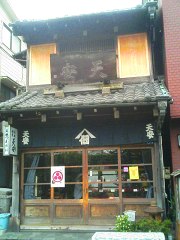
Fishermen in Tsukuda Village, Settsu (the current name is Nishiyodogawa-ku, Osaka City) moved to Tsukudajima under orders from Tokugawa Ieyasu in 1644, and developed the area they had been moved to. As nothing remains the same for long in Tokyo, it has been developed rapidly over recent years but older houses that escaped both the 1923 quake and the infamous air raid remain standing, sandwiched in between enormous skyscrapers.
Tsukudani
Tsukuda always reminds us of tsukudani, a food consisting of small fish and kombu which were fresh caught, boiled down in sweetened soy sauce and eaten. Tsukudani was first concocted by the fishermen of Tsukuda and if not eaten immediately is a useful preserved food for times of shortage. Three tsukudani shops remain in the Tsukudajima of today and are well worth a visit.
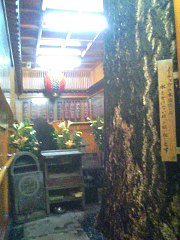

Tsukuda-Tendai-Jizou-Son....There's a very narrow alley between houses (bikes not allowed, enter on foot) which will take you to a Jizou statue. Jizou is god, representing Indian bodhisattva, and protects mainy travelers and children.
Leaving Tsukuda-Jima, enter the market street of Tsukishima, Know for the Tokyo local food of Monja-Yaki. A typical (and traditional) local market street(Shou-Ten-Gai), the street extends all the way to Harumi-Dori.
[MAPID 3: Tsuki Shima]
Have you ever heard of "monjayaki" - a local specialty of the "shitamachi" neighborhoods of Tokyo? There are many monjayaki restaurants in Tsukishima and a so-called "Monja Street" is now a popular sightseeing spot in this area of Tokyo. Tsukishima is built on land reclaimed from the sea in 1892 and developed as an industrial and residential zone in the century since. Until 1988 when the Yurakucho Subway Line opened, it was a most inconvenient place to reach and was almost like an island in its lack of easy access. The area escaped the Great Kanto Earthquake of September 1923 and the Great Tokyo Air Raids of March 1945, and has not undergone large-scale redevelopment to date, thus it retains quaint old back streets and the atmosphere of yesteryear.
Monjayaki
Monjayaki was originally a snack children ate at old-fashioned dagashiya (penny candy stores), in the older districts of Tokyo after the war. Today however, monjayaki is now a kind of meal that is heavier; containing many more ingredients than the original versions would have and is served in approximately 75 places found on and around Nishinaka Dori, a street commonly called Monja Street by Tokyoites.
Go south on Harumi-Dori for one block, and take the Kiyosumi-Dori southwest all the way to the tip of Toyomi-Cho, where you'll see alot of refrigerated warehouses and fish warehouses on both sides of the street. At the dead end, you'll be greeted by the panoramic view of Tokyo Bay.
[MAPID 4: Toyomi Pier]
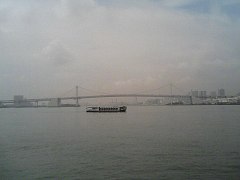
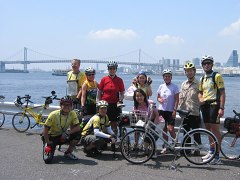
Toyomi Pier overlooking Tokyo Bay is a good location to look at Odaiba, the Rainbow Bridge, and the Shiodome area. Yokohama lies in the direction ahead of the Rainbow Bridge.
Toyomi Pier - Ginza
After you had enough of the view of Rainbow Bridge and the breeze coming across Tokyo Bay, head back on Harumi-dori torwards Ginza. Passing the Tsukiji Fish Market on your left, head a couple of more blocks northwest, and you will see the Kabuki-Za on your right as you enter the Ginza district.
[MAPID 5: Kabuki Za]
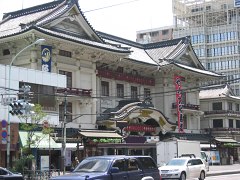
Kabukiza Theater
Kabuki pieces are performed around the year in this theater which was opened in 1889. Shows typically last three to five hours and are divided into three or four acts. Tickets are sold for either a whole show or just a single act. English earphone guides are available.
Two shows per day are performed on most days of the year, one matinee show (usually starting at 11:00) and one evening show (usually starting at 16:30). Consult the website (see external links below) for details. Ticket prices typically range from 2,000 to 20,000 Yen for a whole show (depending on the seat and show) or 500 to 1,500 Yen for just one act. Earphone guides cost 650 Yen for a whole show or 400 Yen for just one act.
12Chome 15, Ginza Chuuo-Ku Tokyo
03-3541-3131
http://www.shochiku.co.jp/play/kabukiza/theater/index.html
Across the Ginza 4-Chome intersection from Kabukisa is Ohnoya, a shop that sells traditional Japanese wardrobes such as yukata,tabi, and sensu. Take a peek inside to look (and buy !) the colorful clothing.
[MAPID 6: Ohno Ya]
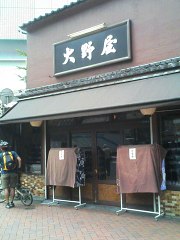
Ohno-Ya has been at Ginza for 130 years, since the beginning of the Meiji Era. Over 350 kinds of Tenugui...traditional hand towels are in stock, made with the same method used to paint Ukiyoe.
5-12-3 Ginza Chuuo-Ku, Tokyo
03-3541-0975
open 10:00-19:00
Tsukiji - Tokyo Tower
On the way from Ginza to Shiodome, then to Shiba-Koen, pass by the Tukiji Central Wholesale Market. On weekday mornings, this area is a very busy and lively place where the fish merchants come to get their fish for the day, where it be for fresh sushi, or to sell to households for their dinner.
[MAPID 7 : Tsukiji Central Wholesale Market]
Ride on Kaigan-Dori past Shiodome, and cross the JR Railroad tracks at the underpass located at Shibaura. You'll begin to see the Tokyo Tower appear in front of you as you approach Shiba-Park. Head towards the tower, and you'll arrive in front of the large red temple gate of Zojoji temple.
[MAPID 8 : Zojoji Temple]

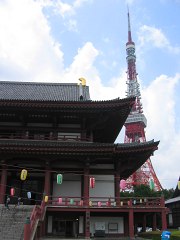
Zojoji Temple was built in the year 1393, and was moved to its present location in 1598. It is the main temple of the Buddhist Jodo sect in the Kanto area. Tokyo Tower now stands just next to the temple. After Tokugawa Ieyasu moved to Edo (former name of Tokyo) in 1590, the Zojoji Temple became the Tokugawa family temple. A mausoleum of the Tokugawa family can be found on the temple grounds, and the crest of the Tokugawa family still decorates the temple buildings. Zojoji's main gate is the Sangedatsumon. It was constructed in 1605 in a contemporary Chinese Tang Dynasty style.
4-7-35 Shiba-Koen Minato-Ku, Tokyo
TEL:03-3432-1431
東京都港区芝公園4-7-35
TEL:03-3432-1431
無休、拝観無料
Leaving the temple, why not see the Tokyo Tower which is so close by ! Even if you don't have time to climb up to the observatory (crowded on weekends), it is quite a view to look up at the tower from the very bottom.
[MAPID 9 : Tokyo Tower]
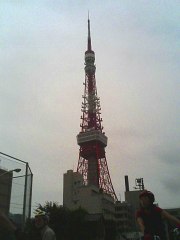
Tokyo Tower(restroom inside) : The symbol of Tokyo in operation from 1958 is 333 meters and has a main observatory at 150 meters and a special observatory at 250 meters high. You can enjoy the view of Mt. Fuji as well as the view of the Kanto plain from the observatory if the weather condition is good. They have a cafe and souvenir stores at main observatory.
4-2-8 Shibakoen, Minato-ku, Tokyo 105-0011 Tel:03-3433-5111
http://www.tokyotower.co.jp/333/foreign/eng/index.html
Tokyo Tower - Imperial Palace
Leaving Zojoji Temple and Tokyo Tower, ride past Hibiya Park to arrive at the Imperial Palace, to finish off the half day ride. (Of course, you can continue your ride to wherever you wish !) Uchibori-dori is car-free on Sundays, when Palace Cycling takes place.
[MAPID 10 : Palace Cycling]

Palace Cycling Course (Restroom nearby) : The Palace Cycling Course a 3 km bicycle path open to the public from Iwaidabashi to Hirakawamon at Uchibori Dori every Sunday from 10a.m. to 3p.m. (Cancel in case of rain) You can use the free rental bicycle service to cycle around the course. Various bicycles are available, from mountain bikes to children's bikes, to tandem bicycles. Of course it's free to ride on your own bike.
パレスサイクリング*近くにトイレあり : 毎週日曜日に皇居前の一般道を自動車通行止めにして実施されているサイクリングコースである。午前10時から午後3時まで。内堀通りの祝田橋~平川門間の往復で約3km。自分の自転車の持ち込みもできるし、レンタサイクルもできる。レンタサイクルでままちゃりや子供用自転車、タンデム、リカンベントを借りてのんびりサイクリングを楽しむ親子連れやカップルがいれば、本格的なロード自転車を持ち込んでのサイクリストも多く見かける。
[MAPID 11 : Imperial Palace]
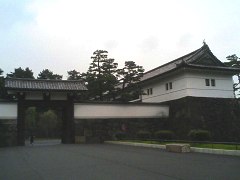
The Imperial Palace : The Imperial Palace is located where Edo-Jo (Edo-Castle) formerly was. It became the imperial palace in 1868 (Meiji 1), and is now the residence of Japanese Imperial family. The palace buildings and inner gardens are not open to public, but East gardens (Higashi Gyoen) are open to the public except Mondays and Fridays. It provides tours visiting The Imperial Palace ( Free for Charge / Reservation necessary).
皇居 The Imperial Palace かつては徳川幕府の居城で江戸城だった。 1868年(明治元年)に皇居となり、現在は天皇とその一家が住んでいる。皇居内の庭園は散策可能である。
1-1 Chiyoda, Chiyoda-ku, Tokyo 100-8111 Tel:03-3213-1111
http://www.kunaicho.go.jp/eindex.html